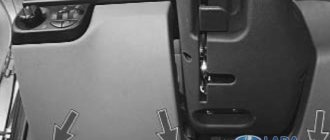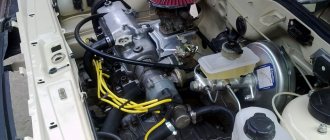From time to time, even maintenance-free and expensive battery models have to be connected to a mains charger. Such an operation cannot be avoided when the car has been sitting in a garage for a long time or has been operated at low engine speeds.
Regardless of the cause of the discharge, many motorists try to replenish electricity without disconnecting the battery from the vehicle’s on-board network. Whether such an operation can be carried out safely and why many vehicle owners use this method will be discussed in detail below.
Is it possible to charge a battery without removing the terminals?
Rechargeable batteries have been used in cars for over 100 years. During this time, car owners became convinced from personal experience that it is possible to charge the battery without disconnecting it from the on-board electrical system.
Many motorists claim that restoring charge using this method is completely safe, but some drivers have encountered serious problems with the car’s electrical equipment.
Is such charging possible?
The ability to charge batteries from a network charger without disconnecting from the vehicle's power supply system is not surprising. Almost all electrical appliances of this type are equipped with crocodile clips, which can be easily connected over the terminals.
It is enough to connect the device correctly (observing the polarity), turn on the device to a 220 V network, and the charging process will be carried out in standard mode. To increase the efficiency of the charger, you must turn off the ignition.
Even not very powerful electronic devices operating during the charging process can significantly increase the period of time required to completely restore the battery.
Unfortunately, devices such as radios and alarms are constantly connected to the car’s on-board network, so completely disabling them can cause significant difficulties.
You will have to put up with such a “standby” load, despite the presence of a significant increase in the time for battery recovery. Otherwise, you will need to disconnect one or both terminals from the battery.
Why you shouldn’t charge like this and what is the danger
As mentioned above, when the charger is connected to the battery without disconnecting the terminals, current from the electrical appliance can flow to electricity consumers operating in standby mode.
If the output voltage of the charging device does not exceed 14.7 Volts, then you should not be afraid for the safety of the equipment. Some chargers can generate voltages significantly higher than this value, which can cause damage to devices that work in the car all the time.
The presence of constantly switched on devices will significantly increase the load on the memory, which is also an undesirable point. For the same reason, the duration of battery charge restoration will increase, so if it is necessary to carry out this operation with minimal time, it is better to disconnect the battery from the vehicle’s on-board system.
How to properly charge the battery without removing it from the car
In practice, many novice drivers do not know how to solve a problem that suddenly arises. In fact, everything is not so difficult, the main thing is to follow certain instructions, not forgetting about general precautions.
Volkswagen
As a clear example, we can cite the algorithm of actions for such a popular car brand as Volkswagen. It consists of performing the following steps:
- First of all, you need to connect the charger wires in pairs to the battery terminals (plus to plus, minus to minus).
- If necessary, you can not even remove the battery plug, in which case the substances released during charging will exit through the ventilation holes in the plug itself.
- If there is no increase in the acid density indicator within two hours, the battery is fully charged.
In addition to safety precautions, a mandatory condition for compliance is the level of charging current, which at the initial stage should not exceed 10% of the total battery capacity.
Further, this indicator should automatically decline.
Renault
It is recommended to perform almost identical actions when charging without removing the battery on Renault models, although experienced motorists still advise limiting yourself to only one positive terminal, removing the negative one. In addition, you should ensure that the charging terminals do not come into contact with the car body.
Peugeot 308
This French small car can easily be charged without removing the battery, which is even more useful for the car itself, given the evaporation of the electrolyte during charging in the removed state. It is important to follow the connection sequence in order to avoid failure of the fuses on the charger being used.
The voltage in this case should be 14-16 V while maintaining a constant current and its initial value of 25-30 A. As the battery is charged, this figure will gradually decrease, and if you have to work with boosters, then all these values are quite easy to control.
Ford Kuga
The American crossover battery is also charged in two ways: with and without removal. In this case, the maximum voltage level does not exceed 15.5 V, since anything higher is already dangerous for the car. In addition, there are a number of other conditions that must be met. Among them:
- Connect to the network only after connecting the charger to the battery. Disconnection is carried out in the same sequence - first charging from the network, and then from the battery.
- It is unacceptable to start the engine and other power units during charging.
- First of all, the “plus” is connected, and then the “minus”. Disabling is done the other way around - first “minus” and then “plus”.
Also, do not forget about special devices that allow you to obtain the most accurate information about the serviceability and condition of the battery, because it is possible that the unit has simply outlived its useful life and needs to be replaced.
Why drivers don't like to disconnect the battery from the network
Many drivers do not like to disconnect the battery from the network. There may be several reasons for this decision:
- Laziness.
- If you turn off the power to the vehicle's on-board system, the settings in many devices that are not equipped with a backup power source can be completely reset. For example, the time in a radio may be lost if the battery installed on the board of this device can no longer cope with autonomously supplying the device with electricity.
- Many drivers are in no hurry to disconnect the terminals again due to possible breakdowns of these elements. According to statistics, when removing and connecting connecting elements, failure of parts occurs much more often than when charging the battery without removing it from the car.
- Disconnecting and reconnecting the terminals may result in insufficient electrical contact. In such a situation, an electric arc may form, which will melt the battery leads and terminals. Many drivers, precisely because of the possible failure of the connecting elements, try to charge the battery connected to the on-board system of the car.
The listed reasons for the reluctance to disconnect the battery are quite convincing, therefore, even despite the possible risks, car owners try to restore the battery charge using this method.
In what case is charging with terminals allowed?
In all cases where the potential danger from disconnecting the terminals from the battery is greater than the likelihood of damage to the equipment from connecting the charger without performing this procedure, it is recommended to connect the DC source without removing the connecting elements from the battery.
If, after disconnecting the terminals from the battery, their further use is impossible, then it is also more advisable to connect charging without disconnecting the wires from the battery.
For example, if there are cracks in the connecting element, such an operation can lead to destruction of the metal. In the absence of spare parts, such a breakdown may lead to the fact that it will no longer be possible to start the engine and, accordingly, operation of the machine will be impossible.
In what cases is it necessary to charge the battery without removing the terminals?
If the car is equipped with volatile electronic devices, even a short-term power outage can cause important settings to be reset, which car owners try to avoid. Another unpleasant consequence of a power outage is the activation of the device’s security lock.
If removing the protection by entering digital codes does not take much time (provided that the driver remembers these codes), then you will have to tinker with restoring the settings.
But the worst thing that can happen when removing the battery is resetting the data in the ECU memory. For example, about daily mileage and fuel consumption, which will affect other related parameters (maintenance period, etc.). When using additional equipment, restoring settings may require contacting the manufacturer's website or service center, which means a large loss of time. Finally, careless or incorrect removal or reattachment of terminals can lead to a voltage surge with very unpleasant consequences for the electronic equipment, especially the powertrain controller. Such a failure will require flashing or, even worse, replacing an expensive unit.
How to charge a battery without removing the terminals
If you decide not to remove the battery from the car and charge the battery without disconnecting the terminals, then this work should be completed without errors. First of all, you need to turn off the ignition, because a working dashboard, ignition system and other devices will consume a significant amount of electricity.
Next, connect the charger. The device should be de-energized if it was previously turned on. Then you need to determine where the positive terminal of the battery is. A red clamp should be connected to it. Accordingly, the black “crocodile” should be connected to the negative terminal of the battery.
At the next stage, the charger is connected to a 220 Volt network. If no errors were made, then immediately after activating the charging mode, the voltage of the required values will begin to be supplied to the battery terminals.
If an automatic device is used, no further action is required. When connecting a device with the ability to adjust the current, it is recommended to set the value of this parameter equal to 10% of the battery capacity.
Is it possible to charge the battery in a car with the engine off without removing the terminals?
Drivers often have another question: is it possible to charge the battery in a car with the engine off? Most experts give a positive answer. They claim that this is the only correct solution, since a running engine can cause unpleasant consequences. Firstly, there is a high probability of damage to the generator and relay regulator. Secondly, a running engine causes the charger to malfunction. This is explained by the fact that it can only function when the engine is turned off.
It should be noted that in practice there are no cases of fire of the electronic control unit while the engine is running. When studying the question of how to properly charge a car battery, we note that it is recommended to restore the battery without removing the terminals with the engine off. This will help avoid damage to the charger.
Carburetor engine
A carburetor engine does not cause problems when implementing this format of battery restoration. This is explained by the fact that these types of internal combustion engines do not have an electronic control unit. Therefore, electronic devices will not be able to burn out. The only thing that is dangerous in this type of engine is the relay regulator, which stabilizes the battery recovery process. But if this device becomes unusable, then only the battery will be recharged.
Thus, when analyzing whether it is possible to charge the battery without removing the terminals with the carburetor engine turned off, we note that it is definitely yes.
Injection engine
This type of internal combustion engine contains a huge number of electronic devices. The main device that controls everything is the electronic control unit. It regulates many vehicle functions. For example, the ignition system. In injection engines, energy is delivered both to all consumers and to the electronic power supply. Consequently, drivers have a question: do they need to remove the terminals when charging the battery? There is an opinion that restoring the battery in this way will disrupt the functioning of the car. However, most experts argue that this is a wrong point of view. To support their words, they give the following arguments:
- Modern electronic control unit systems have a mechanism that protects them from overvoltage.
- The charger's current ranges from 2 to 8 A. This does not pose a threat to the vehicle.
- Most vehicles have ignition switches that stop the operation of all electrical appliances in the car. This avoids current leakage.
- Chargers, as a rule, have the same voltage output parameters as the generator. In modern cars it ranges from 13.8 to 14.6 V. Therefore, electrical devices will not be able to burn out.
Thus, you can charge the car battery without removing it from the car with the injection engine turned off. Moreover, a number of experts strongly recommend restoring the battery in such a way that the settings of various machine systems do not reset.
Diesel engine
This type of engine also allows you to charge the car battery without removing it from the car, with the engine turned off. The stability of its functioning is ensured thanks to a huge number of interacting systems that operate under the control of an electronic unit. Therefore, there is a possibility that the devices in the car may catch fire. But in practice, such cases have not been registered.
Precautionary measures
When working with electric current, safety comes first. For this reason, it is prohibited to perform this operation in a damp room. Failure to comply with this requirement may result in electric shock or damage to the charger.
Modern battery charging devices are well protected from polarity reversal. If the terminals are connected incorrectly, the fuse will blow, but the main circuit should remain unaffected.
It is not recommended to check the functionality of the safety elements, so you should be careful when connecting the wires coming from the charger to the battery.
All electrical contacts must be in perfect working order. The presence of sparks in the immediate vicinity of flammable substances can result in a fire.
Still have questions or have something to add? Then write to us about it in the comments, this will make the material more useful, complete and accurate.











